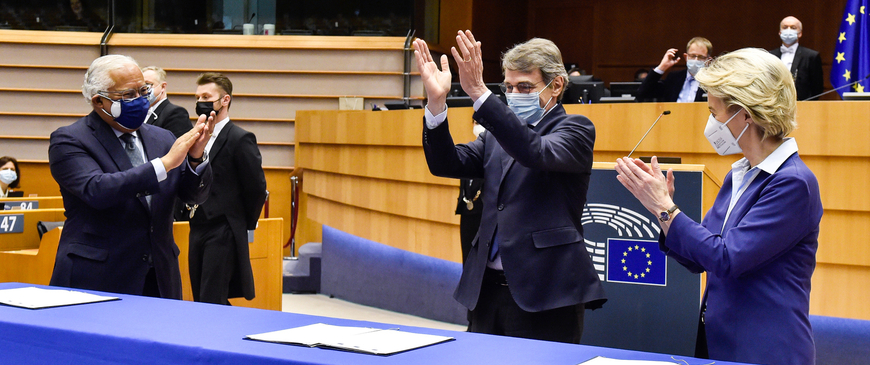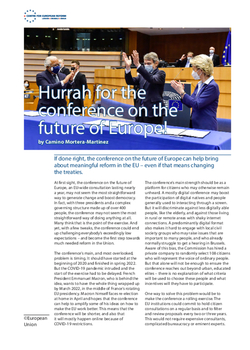
Hurrah for the conference on the future of Europe!
If done right, the conference on the future of Europe can help bring about meaningful reform in the EU – even if that means changing the treaties.
At first sight, the conference on the future of Europe, an EU-wide consultation lasting nearly a year, may not seem the most straightforward way to generate change and boost democracy. In fact, with three presidents and a complex governing structure made up of over 400 people, the conference may not seem the most straightforward way of doing anything at all. Many think that is the point of the exercise. And yet, with a few tweaks, the conference could end up challenging everybody’s exceedingly low expectations – and become the first step towards much needed reform in the Union.
With a few tweaks, the conference on the future of Europe could end up challenging everybody’s exceedingly low expectations – and become the first step towards much needed reform in the Union.
The conference’s main, and most overlooked, problem is timing. It should have started at the beginning of 2020 and finished in spring 2022. But the COVID-19 pandemic intruded and the start of the exercise had to be delayed. French President Emmanuel Macron, who is behind the idea, wants to have the whole thing wrapped up by March 2022, in the middle of France’s rotating EU presidency. Macron himself faces re-election at home in April and hopes that the conference can help to amplify some of his ideas on how to make the EU work better. This means that the conference will be shorter, and also that it will mostly happen online because of COVID-19 restrictions.
The conference’s main strength should be as a platform for citizens who may otherwise remain unheard. A mostly digital conference may boost the participation of digital natives and people generally used to interacting through a screen. But it will discriminate against less digitally able people, like the elderly, and against those living in rural or remote areas with shaky internet connections. A predominantly digital format also makes it hard to engage with local civil society groups who may raise issues that are important to many people, and who already normally struggle to get a hearing in Brussels. Aware of this bias, the Commission has hired a private company to randomly select 108 citizens who will represent the voice of ordinary people. But that alone will not be enough to ensure the conference reaches out beyond urban, educated elites – there is no explanation of what criteria will be used to choose these people and what incentives will they have to participate.
One way to solve this problem would be to make the conference a rolling exercise. The EU institutions could commit to hold citizen consultations on a regular basis and to filter and review proposals every two or three years. This would not require expensive consultants, complicated bureaucracy or eminent experts. Possibly the most effective way to understand what citizens really think is to have a coffee with them. Of course, no EU leader could ever find the time to have coffee with over 500 million people. But they can travel to EU countries and engage with local communities, as national politicians do. A recent EU poll shows that most Europeans would be willing to participate in the conference if given the chance. The EU should exploit this interest by using every possible means to connect with its citizens, from school campaigns and expert panels to prime time TV and town hall meetings. This should be part of the Union’s DNA in the years to come.
Citizens seem eager to talk. The EU should exploit this interest by using every possible means to connect with its citizens, from school campaigns to prime time TV. This should be part of the Union’s DNA in the years to come.
A more obvious but less serious problem is the conference’s complicated governing structure. An executive board made up of representatives of at least six EU institutions will decide how the conference will operate and oversee its work with the help of a common secretariat. The conference plenary, consisting of representatives of parliaments, citizens and the EU institutions, will meet every six months to discuss the ideas put forward by citizens. The leaders of the Commission, the European Council and the European Parliament will jointly preside over the conference. If that sounds like too many cooks, that’s because it is. But this need not be an issue. The problem is not how many presidents the conference has, or even who gets to lead it. The problem is whether or not the governing structure, however abstruse it may be, will be able to spot the most important issues for citizens, and crucially, do something about them. Previous soul-searching attempts, like former Commission President Jean Claude Juncker’s white paper on the future of Europe, failed because, ultimately, nobody was responsible for addressing the problems identified.
The problem is not how many presidents the conference has. The problem is whether or not the governing structure, however abstruse, will be able to spot the most important issues for citizens, and crucially, do something about them.
To be successful, or at least, credible, the conference should consider all the available means to act on citizens’ concerns, including, possibly, treaty change. Most EU governments do not want to risk changing the treaties, which would require unanimity and referendums in several countries. That is a legitimate concern, as EU leaders fret about mounting euroscepticism – and reopening the treaties may cause serious political crises in countries with EU-hostile governments. But leaders should not shy away from treaty change. The COVID-19 pandemic has shaken the continent in previously unthinkable ways. For the first time, the EU negotiated a deal with vaccine makers on behalf of its member-states. To weather the economic crisis, the Union temporarily suspended its fiscal rules and agreed on a recovery fund that includes the issuing of EU debt. The pandemic has also exposed a darker side: the crisis led to more border checks and temporary restrictions to the free movement of people in the EU; and COVID-19 laid bare the EU’s dependency on other parts of the world for the procurement of health equipment and medicines, at a time of increased international tensions.
While restrictions on travel will ease as the pandemic recedes, the wider debate on the role of the EU in times of crisis will not. The Commission is considering setting up a Health Union, to deal with public health emergencies better, for example, by jointly developing vaccines. Such a union would take health competences away from member-states, which would, in turn, require treaty change. If the recovery fund works, EU governments may be willing to make it permanent and to overhaul the Union’s debt and deficit targets. This too, will require rewriting the treaties.
Beyond the pandemic, the EU may want to rethink other issues that matter to citizens. According to EU polls, a large majority of Europeans want the EU to have a common foreign and security policy. But the EU often finds itself paralysed because one country can veto common action. Changing this would require a unanimous decision of the European Council. Similarly, the conference could help with another complex matter: how to run the 2024 European elections. While voter turnout in 2019 was the highest since 1994, the result satisfied no one – EU leaders ignored the Parliament’s lead candidate system (whereby the candidate of the party with the most seats should become Commission president) but ended up with Ursula von der Leyen – no one’s first choice.
Changing the treaties – or even tweaking some rules – will not be easy. But if doing so would make the EU more effective, then EU leaders should not waver. After months of a trying health and economic crisis, EU citizens could be forgiven for wondering what the value of the EU is. The conference should help to answer that question.
Camino Mortera-Martinez is a senior research fellow at the Centre for European Reform.

